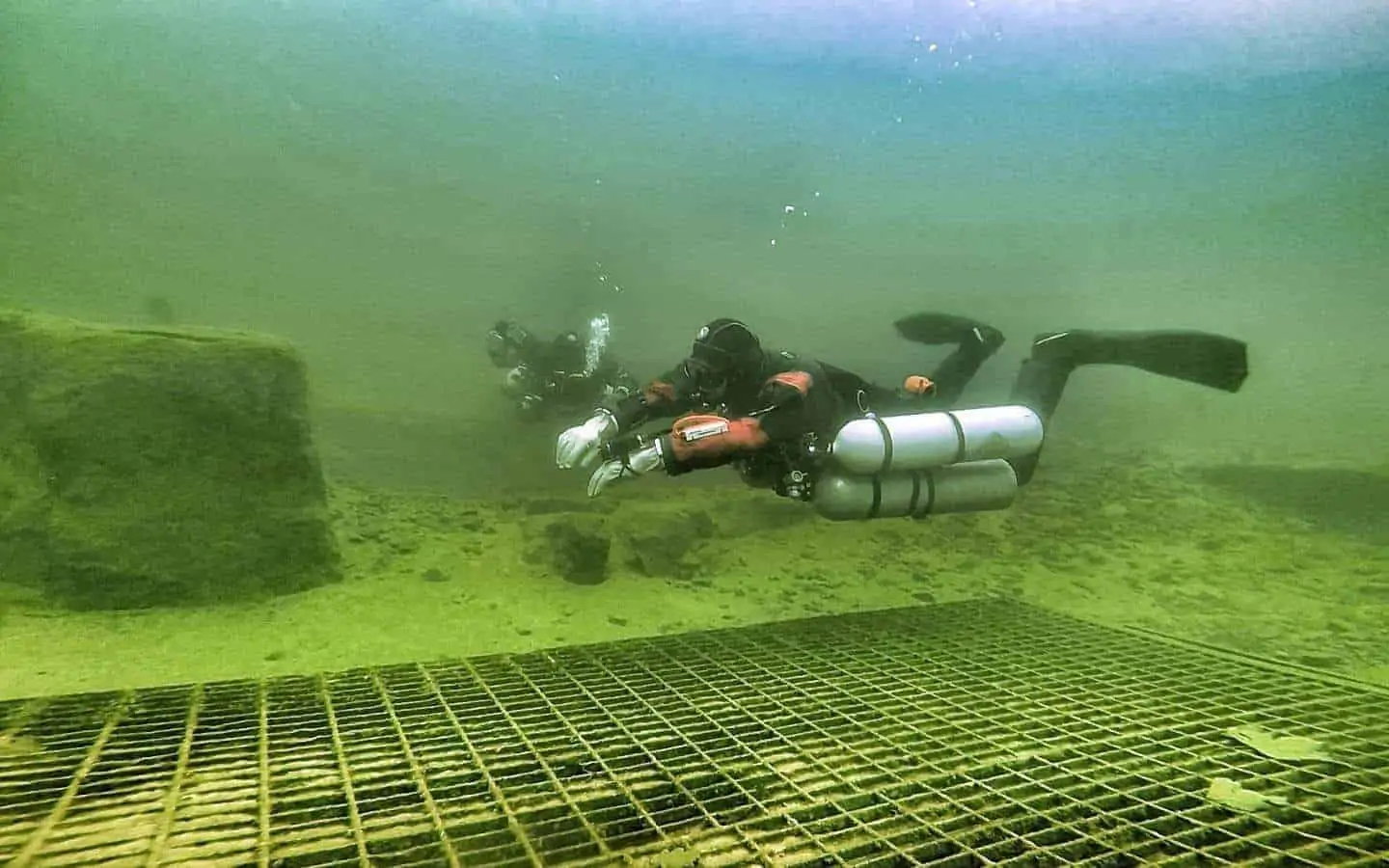This month, our panel of experts tackle the subject of finning techniques, and offer up a plethora of helpful hints and advice to get you gliding around like a dive god in no time
Nothing screams ‘dive guru’ as much as the sight of someone in a nice horizontal trim, effortlessly gliding through the water using a frog kick, and making fine manoeuvres such as helicopter turns and back finning seem a walk in the park. Getting a measured, smooth finning style in an array of techniques is what sets more-experienced divers apart from those just setting out on their underwater journey, but all it needs is practice, practice, practice.
We asked a selection of highly qualified instructors from the main training agencies for their insights into this topic, and they came back with some useful hints and advice.
PADI TecRec Instructor Trainer Martin Robson said: “If you want to learn to ‘frog kick’, practice on dry land first. Lay across a table or bench, ideally watched by an instructor who can coach you (a cave instructor would be ideal). Get videoed practicing in the water. I actually swim behind my students, holding their ankles and making their legs ‘frog kick’ until they get the feel of it. Practice just beneath the surface with your hands against the side so you don’t actually go anywhere.”
Emily Petley-Jones, UK Regional Training Consultant at PADI and a PADI Course Director, also endorsed this finning style, saying: “I prefer to frog kick, but it is important that you have got your trim and buoyancy sorted to be able to frog kick efficiently. If you are just experimenting with your kicking style, get yourself into a hover in your normal swimming position, then practice a few kicks. The fins you wear will also have an effect on your finning style, so if you can, experiment with different styles of fins.”
Matt Clements, PADI UK Regional Manager and a PADI Master Instructor, explained: “Finding the right set of fins is key, you need to try a few different styles out. Think about the environment you are diving and how much kit you are needing to shift. Ill-fitting fins tends to lead to rubbing, sore feet and worse, leg cramps. Fins that are too heavy or buoyant will throw off your trim in the water. I tend to use the frog kick at a leisurely pace, which with subtle ankle movements allows for turning and back finning. Your fins should also allow for powerful kicks also for use against currents, or to get to your buddy in an emergency. To get the most out of the flutter kick, you need to kick from the hip and using the full range of leg movement.”
Vikki Batten, who is Director of Rebreather Technologies, and a Training Supervisor and Instructor Examiner, at PADI said: “Simple fins give you the widest variety of fin strokes, so don’t worry about too many fancy bits unless you have an injury or weakness to compensate for. Most people don’t have good awareness of their finning technique, so get some training from an expert who can help you develop both powerful and subtle fin strokes.”
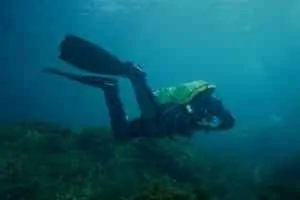
Mark Powell, TDI/SDI Business Development Manager, said: “Most divers are only ever taught a single finning technique, the flutter kick. This is simple and easy involving the same leg movement as a front crawl stroke in swimming. However, it has a number of disadvantages, biggest of which is that it tends to kick up silt, even if you don't touch the bottom. There are a number of other finning techniques, including the frog kick, helicopter turn and back kick. Each of these can be very useful in the right situation, and divers should be able to use the most appropriate kick for the situation.
“Frog kicks can be used as a replacement for flutter kick when swimming in silty conditions as all the force is directed backwards during the power stroke and so it avoids disturbing the bottom. Helicopter turns are very useful for adjusting your position in the water, or for turning around to check on your buddy. Back finning can be used to hold position or to back away when trying to take a photograph, approaching a reef or other delicate surface, or when trying to maintain your distance on a decompression stop.
By expanding their repertoire of finning techniques, divers can gain a number of benefits. Using the right technique at the right time can help to reduce silt being kicked up on a wreck and, as a result, visibility of dives is increased. It can allow divers to switch from using one set of muscles to another and so reduce fatigue, and finally it can allow a much greater level of control over the diver’s position in the water. All of these can increase the enjoyment and comfort of a dive, and that’s something that should appeal to divers of all levels.”

Sophie Heptonstall, National Diving Officer of the British Sub-Aqua Club, said: “Mastering different finning techniques can often be undervalued at the start of diver training when there are so many new skills for a diver to learn, however good basic finning technique is essential for economical, stress-free and relaxed diving at initial qualification level and becomes increasingly important with more adventurous diving.
“When it comes to fins, comfort is important, particularly in the foot pocket to reduce discomfort in the water. The range of materials and style of fins now available are vast and it’s important to try different types to see how they perform in the water using different fin strokes. Ask shops, dive sites, clubs or friends if you can try different types before you buy a new pair. The rigidity and shape of the fins can make a big difference in effort and propulsion.”
She continued: “Correct weighting and trim are the backbone for good finning technique. How you are positioned in the water makes a significant difference to a diver’s propulsion and efficiency. Practice your surface and underwater finning, if possible get someone to take video of you in the water so you can see your ankle, leg and fin positioning. This will help you work on improving your technique.
“It is important to choose the right kick for the dive. The flutter kick is great for maximum propulsion where there is no risk of disturbing the sea bed or damaging marine life; the frog kick is useful for relaxed diving where there is little current and no risk of disturbing the sea bed or damaging marine life; the high flutter kick / high frog kick is a good technique for silty conditions or a confined space; and the reverse frog kick is a great alternative to pushing with the arms or sculling to back away from something underwater.”
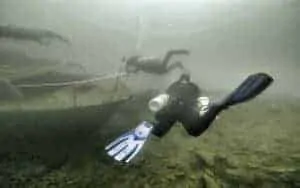
Garry Dallas, Director of Training for RAID UK and Malta, said: “Surfacing after an hour’s dive may feel like you’ve just undergone a strenuous workout at the gym. Not surprising, considering you’ve just burnt off around 650 calories – roughly equivalent to that well-earned hot chocolate and burger you’ll enjoy on your surface interval!
“Have you ever paused to think why you’re so tired post-dive? Simply put, you’re working too hard underwater! Constant flutter kicking throughout a dive, trying to keep up with the diver on point, fighting the effects of each kick, and pushing a larger frontal surface area through the water all contribute to excess exertion and air consumption.
“Spending nearly 20 years analysing diver’s kicks, I can put diver’s nemeses of correct effective finning techniques into perspective.
For example, kicking from the hips uses the largest muscle groups (quadriceps and gluteus maximus) in the body, trending the forward or reverse bicycle kick, which is not very efficient. Having one stronger leading leg – noticed when asked to swim in a straight line without any point of reference – results in swimming in an arc or a circle! A graceful frog kick and glide is balanced, anti-silting, effective and effortless, while a helicopter turn is half a frog kick and half a reverse kick with each leg simultaneously.”
He pointed out: “Tech fins are not just for tech divers! Neutral or slightly negative fins rule! Split fins can still cause cramp. Equally, ankle weights do not stop your feet from floating, they simply hold your feet down without air in your boots. Having excess weight on your feet requires excess air to support them neutrally in the water to feel comfortable while hovering.
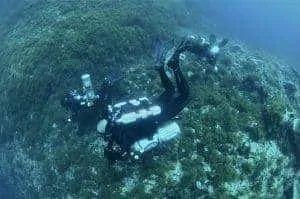
Tim Clements from IANTD, explained: “IANTD places great emphasis on efficient propulsion. Moving through water requires 25 times as much effort as air, which when combined with the bulk of technical diving gear, means we either have to work smarter or harder to explore our diving objectives. This comes in several parts: streamlining, good trim and efficient propulsion. Let's take a look at how we can improve how we can get more progress forwards (or backwards) for the same effort. Good propulsion also minimises silt disturbance and environmental damage in delicate caves or reefs and maximises positional control.
“It is important to have several propulsion techniques. A full power frogkick might be ideal for making progress in a strong current, but fine control over position or attitude in cave navigation, photography or teaching requires either flutter, modified flutter or delicate back kick technique. Dolphin kick is another useful number, especially when modified into a single move forward. Knowing when to use each of these is a skill in itself. Underlying good propulsion is, of course, crisp buoyancy control – if you're baling up and down in the water, then great propulsion technique is wasted effort. Whatever technique you use, practice it slowly, placing emphasis on accurate movement and thinking carefully about where you are pushing water with your fins. Don't try and break the laws of physics!”
He continued: “IANTD courses firstly require divers to be stable and streamlined, proceeding to work on trim and propulsion. Development of the last two often proceeds together for many divers, with a flatter profile making movement easier, but good propulsion makes the diver flatter. This ‘chicken and egg' technique development is common, but it is also important to recognise the many situations that make good propulsion in ‘non-flat' attitudes important – caves, wreck, reefs, teaching, photography, science, etc, can all take us away from a perceived ideal ‘spirit-level flat'.
“IANTD aims to train divers for the many real diving scenarios they will encounter – the advice from us is to become proficient in many techniques. Also, pay attention to other factors that also help such as good trim, streamlining and buoyancy stability. Finally, make propulsion part of your visualisation and post-dive team debrief to identify improvements or different techniques. If your buddy has some video, analyse what you are doing and make positive changes. Aim to self-improve beyond your formal training and reap the benefits in the enjoyment of your diving. If you would like to spend more time on propulsion with an instructor, then the Essentials course is for you.”
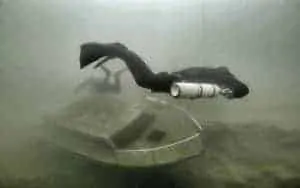
GUE’s John Kendall said: “One of the things that most of my students find hardest is to unlink their finning and their buoyancy. By attaining a good flat body position, all the finning techniques become easier and more efficient, and don’t cause us to go either up or down. By far the best way of doing this is to keep your head as far back as you can, and your arms held out in front of you (think ‘Superman’). From this position we can then think about actually kicking. We want our kick to move the water horizontally behind us, anything else is just wasted energy, so a frogkick is a great starting point. Bend your knees and keep your fins parallel to the floor. Then move your feet apart, twist your ankles and bring the bottoms of your feet together. Then enjoy the glide before repeating. Don’t rush the kick, and ensure that the bottoms of your fins ‘push’ against the water. It is important to try and avoid allowing your knees to go up and down during this kick, the power comes from the calf muscles, not the thighs. Practice this kick very close to the bottom in a pool or on a platform, and you will feel your knees touching if you are using your thighs.”
Photographs by Mark Evans, Garry Dallas, RAID and TDI/SDI
